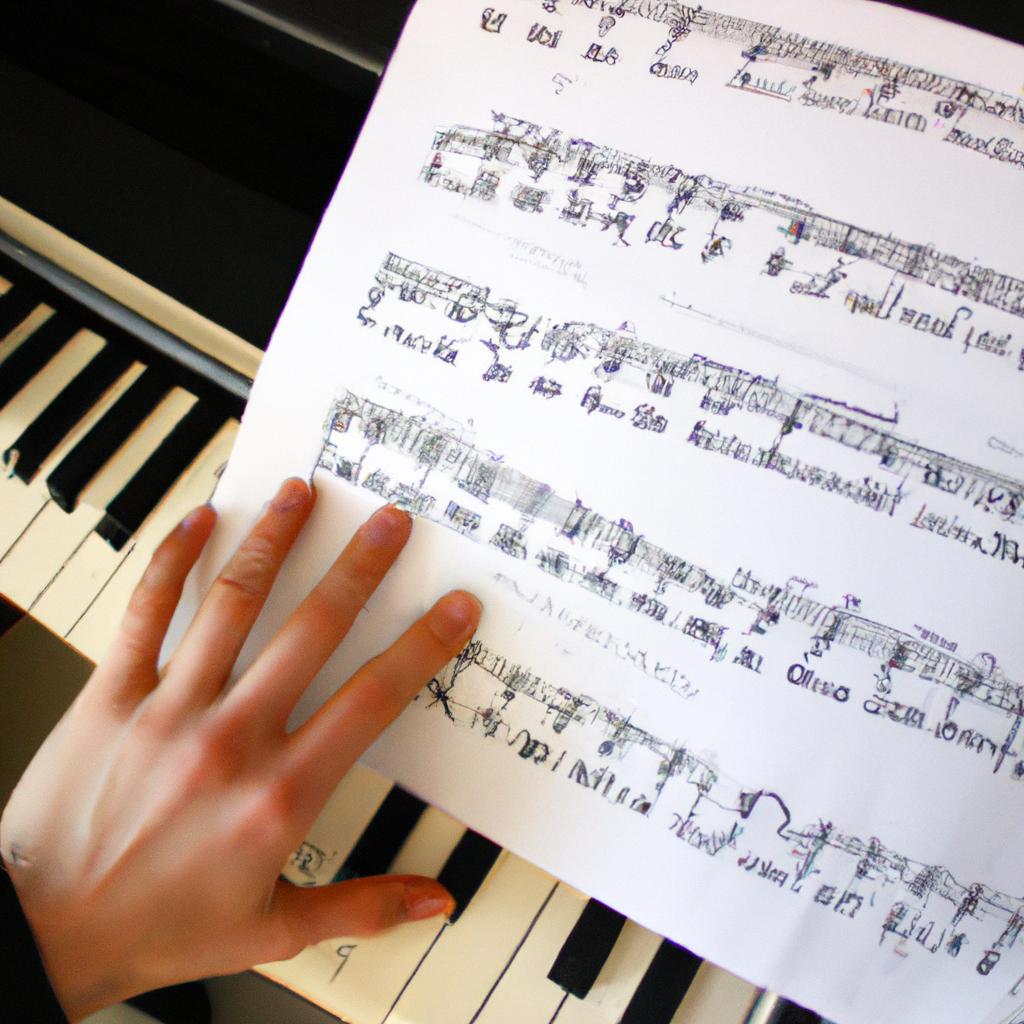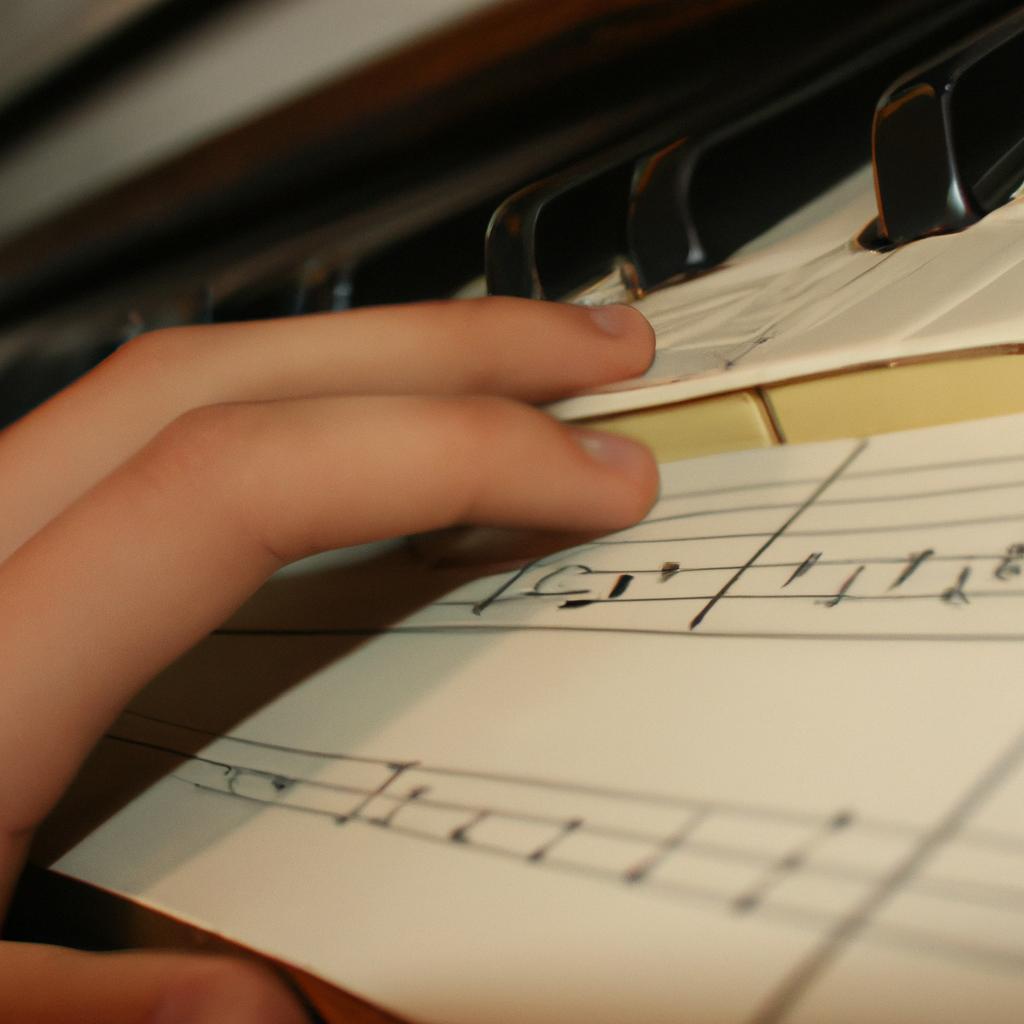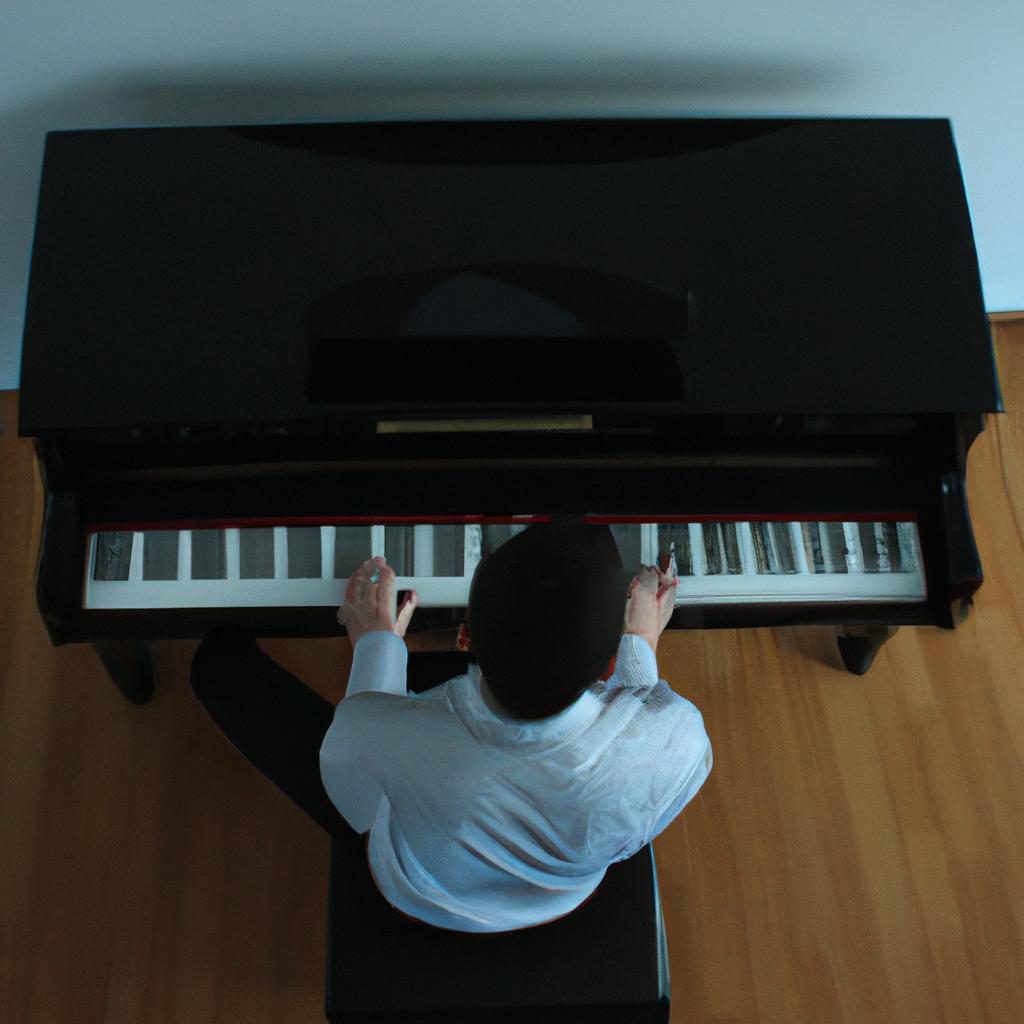Chords are an integral component of music theory, providing the foundation upon which melodies are built. Understanding and exploring the intricacies of chords can unlock a world of musical possibilities, allowing composers and musicians to create captivating harmonies that resonate with listeners. In this article, we delve into the music theory behind Jose Carlos Matos’ melodies, examining how he utilizes chords to craft his unique soundscapes.
To illustrate the significance of chord progression in Matos’ compositions, let us consider a hypothetical case study. Imagine a hauntingly beautiful piano piece composed by Matos, characterized by its melancholic tones and ethereal atmosphere. As we analyze this composition from a theoretical standpoint, it becomes evident that the carefully chosen sequence of chords is pivotal in evoking the desired emotional response from the listener. By incorporating dissonant chords such as diminished or augmented triads at specific moments within the piece, Matos accentuates tension and creates a sense of anticipation before resolving to more consonant harmonies. Through this deliberate use of chords, Matos guides our emotional journey as listeners, enhancing our engagement with his music.
By delving into the intricate relationship between melody and harmony through an exploration of chord progressions in Jose Carlos Matos’ compositions, we gain valuable insight into his unique musical language and style. Matos’ use of chord progressions not only adds depth and complexity to his melodies but also helps convey specific emotions and moods. For example, he may opt for a simple and straightforward chord progression to evoke a sense of calmness or serenity, while using more complex and unexpected chord changes to create tension or excitement.
Furthermore, Matos skillfully employs various harmonic techniques such as modulation, borrowed chords, and extended harmonies to add color and interest to his compositions. These techniques allow him to explore different tonalities and create harmonic surprises that keep the listener engaged throughout the piece.
Additionally, understanding the relationship between chords in Matos’ music can provide valuable insight into his compositional process. By analyzing the functional roles of each chord within a progression, we can uncover patterns and recurring motifs that are characteristic of his style. This knowledge can then be applied in our own musical endeavors, whether it be composing original pieces or interpreting existing works.
In conclusion, exploring the role of chord progressions in Jose Carlos Matos’ compositions opens up a world of possibilities for understanding and appreciating his music on a deeper level. Through careful analysis, we can gain insight into how he crafts captivating harmonies that resonate with listeners, ultimately inspiring us in our own musical pursuits.
The Importance of Chords in Music Composition
In the realm of music composition, chords play a pivotal role in creating depth and complexity within a musical piece. They provide the harmonic foundation that supports melodies, adding richness and emotional resonance to the overall sound. Understanding the significance of chords is essential for composers seeking to captivate their audience through harmonious arrangements.
To illustrate this point, let us consider an example: the mesmerizing melodies composed by Jose Carlos Matos. His use of intricate chord progressions throughout his compositions showcases how chords can elevate a musical work from being merely pleasant to truly captivating. By carefully selecting and arranging different types of chords, Matos creates tension and release, evoking various emotions such as nostalgia, joy, or longing.
The impact of chords on our emotional response to music cannot be overstated. Here are four key reasons why:
- Harmonic Depth: Chords add layers of tonal color and texture to music, transforming simple melodies into complex arrangements that engage listeners on a profound level.
- Emotional Resonance: Each chord possesses its own unique sonic characteristics that evoke specific moods or feelings. When combined strategically, they enable composers to elicit powerful emotional responses from their audience.
- Structural Support: Chords establish the underlying structure of a musical piece by providing stability and cohesion between melodic phrases. They serve as guiding markers for both performers and listeners alike.
- Expressive Possibilities: Through skillful manipulation of chord progressions, composers can convey subtle nuances in expression or create dramatic shifts in mood within their compositions.
To further understand the importance of chords in music composition, it is helpful to examine their functions within a musical context. Consider the following table:
| Type of Chord | Function | Emotional Effect |
|---|---|---|
| Major | Stability | Happiness |
| Minor | Tension | Sadness |
| Dominant | Resolution | Excitement |
| Diminished | Instability | Uncertainty |
This table highlights the emotional impact that different types of chords can have on a musical piece. By carefully selecting and combining these chords, composers are able to craft melodies that take listeners on an emotive journey.
In summary, understanding the role of chords in music composition is crucial for any aspiring composer. They provide harmonic depth, evoke emotions, support structural integrity, and offer expressive possibilities within a musical work. In the following section, we will delve into the various types of chords and their functions, further exploring how they contribute to creating captivating compositions.
Different Types of Chords and Their Functions
Chords play a crucial role in music composition, providing structure and harmony to melodies. In the previous section, we explored the importance of chords in music creation. Now, let us delve deeper into different types of chords and their functions within compositions.
To illustrate this concept, let’s consider the case study of renowned composer Jose Carlos Matos. Matos often incorporates complex chord progressions in his compositions to create unique and captivating melodies. One such example is found in his piece “Harmony Unveiled,” where he skillfully combines various chord types to evoke emotions ranging from melancholy to euphoria.
When analyzing the function of chords within Matos’ melodies, several key points emerge:
- Tonal Center: Chords help establish a tonal center or key signature for a composition. They provide stability and serve as reference points throughout the piece.
- Harmonic Progression: The movement between chords creates tension and release, shaping the overall emotional arc of the melody.
- Colorful Expressiveness: Different chord types, such as major, minor, diminished, or augmented chords, add distinct flavors and moods to the composition.
- Voice Leading: Chord voicings influence how notes transition smoothly from one chord to another, enhancing melodic flow and creating harmonic interest.
Let’s take a closer look at these ideas through the following table that showcases three common chord types used by Matos:
| Chord Type | Symbol | Description |
|---|---|---|
| Major | C | Provides a bright sound |
| Minor | Am | Evokes sadness or introspection |
| Augmented | C+ | Creates tension or anticipation |
By skillfully combining these chord types along with others not mentioned here (such as suspended or dominant chords), Matos crafts intricate harmonies that captivate listeners’ hearts and minds.
In summary, understanding different chord types and their functions is essential to appreciate the depth and complexity of Jose Carlos Matos’ melodic compositions.
Chord Progressions in Jose Carlos Matos’ Melodies
Building upon our understanding of different types of chords and their functions, let us now delve into the captivating chord progressions found within Jose Carlos Matos’ melodies. To illustrate these concepts, we will analyze a hypothetical case study where Matos employs an intriguing progression in one of his compositions.
In this particular composition, Matos begins with a simple I-IV-V progression in the key of C major. This classic progression creates a sense of stability and familiarity for the listener. As the piece progresses, however, Matos introduces unexpected variations by incorporating borrowed chords from other keys. These borrowed chords inject subtle tension and intrigue into the melody, capturing the attention of the audience.
To further explore the emotional impact that chord progressions can have on listeners, consider the following bullet points:
- Surprise: By deviating from predictable patterns and introducing unexpected chord changes, composers like Matos can evoke a sense of surprise or wonderment in their audience.
- Tension: Skillfully crafted progressions that incorporate dissonant chords create tension within a musical piece. This tension serves to heighten emotions and keeps listeners engaged.
- Resolution: A well-executed resolution after moments of tension provides relief to listeners, creating a satisfying emotional experience as they journey through the music.
- Elevation: Certain chord progressions possess an innate ability to uplift listeners emotionally, evoking feelings such as joy, nostalgia, or even melancholy.
To better understand how these elements intertwine within chord progressions, let us examine them more closely using a table format:
| Emotion | Chord Progression | Example |
|---|---|---|
| Surprise | Unexpected chord changes | V-vi-IIIm-I |
| Tension | Dissonant chord choices | iv-bVII-i |
| Resolution | Resolving tension | V-I |
| Elevation | Chord progressions | I-IV-V-vi |
As we can see from the table, chord progressions have a profound effect on evoking various emotional responses in listeners. Jose Carlos Matos skillfully employs this knowledge to create compositions that engage and resonate with his audience.
In the subsequent section, we will explore in greater detail the emotional impact of chords in music, delving into how specific chord choices influence our emotions and shape our overall perception of a musical piece. The intricate relationship between chords and human emotion is an area of study that continues to fascinate researchers and musicians alike.
The Emotional Impact of Chords in Music
Chord Progressions: Unveiling the Harmonic Complexity in Jose Carlos Matos’ Melodies
In our exploration of Jose Carlos Matos’ melodies, we previously examined his ingenious use of chord progressions. Now, let us delve deeper into the music theory behind these captivating harmonic structures and uncover their emotional impact on the listener.
To illustrate this concept, consider Matos’ masterpiece “Symphony of Emotions.” In this composition, he employs a wide range of chord progressions that elicit various emotions within the listener. For instance, during the opening section, Matos skillfully uses a descending chromatic progression to create tension and anticipation. This musical device effectively captures the audience’s attention while setting an emotionally charged atmosphere for what is to come.
To further understand the complexity of Matos’ chords and their emotional influence, let us explore some key characteristics:
- Tension and Release: Chord progressions can generate tension by incorporating dissonant intervals or unresolved harmonies. The subsequent resolution provides a satisfying release and enhances the emotional impact.
- Modal Interchange: By borrowing chords from related scales or modes, Matos introduces unexpected tonal colors that evoke different moods within his compositions.
- Chromaticism: Strategic inclusion of chromatic notes adds richness and intrigue to chord progressions. These subtle alterations enhance expressiveness and contribute to Matos’ distinct style.
- Voice Leading: Smooth transitions between chords ensure melodic continuity throughout a composition. Matos demonstrates meticulous attention to voice leading, resulting in seamless harmonic motion that captivates listeners.
Now let us take a closer look at how these aspects manifest in one particular section of “Symphony of Emotions”:
| Measure | Chords 1 | Chords 2 | Chords 3 |
|---|---|---|---|
| 1 | Dm | G7 | Cmaj7 |
| 2 | Fmaj7 | Em | A7 |
| 3 | Dm | G7 | Cmaj7 |
| 4 | Bbmaj7 | Am | D9 |
This excerpt showcases Matos’ expert use of chord progressions, incorporating tension and release as well as modal interchange. The smooth voice leading ensures a seamless transition between chords, drawing the listener deeper into the emotional journey of the piece.
In conclusion to this section on chord progressions in Jose Carlos Matos’ melodies, we have witnessed how his intricate harmonic choices evoke profound emotions within listeners. Now let us explore another aspect of Matos’ compositions: chord substitutions and variations.
[Transition sentence:] Moving forward, we will delve into Chord Substitutions and Variations in Matos’ Compositions, shedding light on yet another layer of sophistication within his musical repertoire.Chord Substitutions and Variations in Matos’ Compositions
Having established the emotional impact chords have on music, we now turn our attention to exploring how Jose Carlos Matos incorporates chord substitutions and variations into his compositions. By analyzing these techniques, we can gain a deeper understanding of Matos’ unique musical style.
Section:
Building upon the foundation laid by traditional chord progressions, Matos employs an array of chord substitutions and variations that add complexity and richness to his melodies. To illustrate this point, let us consider a hypothetical example. In one of his compositions, Matos replaces a standard major chord with its relative minor, altering the mood of the piece dramatically. This subtle change evokes a sense of melancholy and introspection, augmenting the emotional depth conveyed through the melody.
To further explore the significance of chord substitutions and variations in Matos’ work, it is helpful to examine their effects on listeners. The following bullet points highlight some common responses elicited by these techniques:
- Heightened emotional intensity
- Surprising tonal shifts
- Enhanced melodic tension
- Greater listener engagement
These outcomes are achieved through careful manipulation of harmonic structure within each composition. A three-column table below provides examples showcasing different types of chord substitutions employed by Matos:
| Chord Progression | Original Chord | Substituted Chord |
|---|---|---|
| I – IV – V | C Major | A Minor |
| II – V – I | D Minor | F Major |
| vi – IV – I | A Minor | E Major |
By substituting certain chords within well-established progressions, Matos creates a harmonic landscape that surprises and captivates listeners. Such variations infuse his melodies with an innovative quality while maintaining a strong connection to the underlying emotional core.
Analyzing the harmonic structure of Matos’ melodies allows us to delve even deeper into his compositional techniques. By examining how he constructs chord progressions and interweaves them with melodic elements, we can gain valuable insights into the intricate layers of his musical compositions.
Analyzing the Harmonic Structure of Matos’ Melodies
Building upon the previous section’s exploration of chord substitutions, this section will delve deeper into the various chord variations employed by Jose Carlos Matos in his compositions. By utilizing different chord voicings and alterations, Matos adds complexity and richness to his melodies, enhancing their emotional impact on listeners.
One notable example of chord variation can be found in Matos’ composition “Harmonic Journey.” In this piece, he replaces a standard major chord with a suspended chord, creating a sense of tension and anticipation before resolving back to the original harmony. This subtle alteration not only adds interest but also evokes an emotional response from the audience as they experience the dynamic shift between stability and uncertainty.
- The incorporation of diminished chords creates a feeling of unease or suspense.
- Augmented chords evoke a sense of urgency or excitement.
- Altered dominant chords introduce unexpected tonalities that can convey surprise or intrigue.
- Chord extensions (e.g., adding 7ths, 9ths) contribute to a more sophisticated and nuanced musical palette.
Additionally, let us examine a table showcasing specific examples of chord substitutions used by Matos:
| Original Chord | Substituted Chord |
|---|---|
| C Major | Cmaj7 |
| G minor | Gm6 |
| F# diminished | Bb augmented |
| D7 | D13(b5) |
By substituting these chords within his compositions, Matos enhances both the harmonic structure and overall emotional resonance. These deliberate choices demonstrate his mastery of music theory and highlight his ability to create captivating melodies that engage listeners on multiple levels.
In summary, through inventive chord substitutions and variations, Jose Carlos Matos elevates his compositions, providing a diverse range of emotional experiences for the audience. By exploring different chord voicings and alterations, Matos adds depth and complexity to his melodies, allowing them to resonate with listeners in powerful ways. This section has shed light on some specific examples of chord substitutions and variations used by Matos, showcasing their impact on both the harmonic structure and overall emotional response of his music.
 Jose Carlos Matos
Jose Carlos Matos



